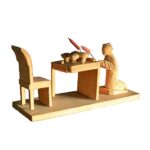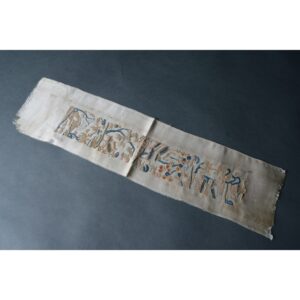Miniature figure of offering to ancestors
A miniature statuette of a worshipper making an offering to his ancestor, before a table or altar on which are vessels containing gifts and incense. The empty chair represents a place for the soul of the departed. On the home altar in the house or on the family ancestral altar, ancestral tablets or lingpai 靈牌 are often kept, with the name of the deceased and the years of birth and death. According to Chinese belief, the souls of the deceased are in these wooden tablets. Incense is burned in front of them daily, and food, especially fruits and vegetables, is sacrificed twice a month. Ancestor worship, the earliest forms of which are found in the Neolithic cultures of China, is based on the mutual relationship between the living and the dead and the belief that the dead can intercede with deities on behalf of their living descendants. People must take care of the souls of deceased family members and other ancestors, provide them with a comfortable life in the afterlife, and ... more
A miniature statuette of a worshipper making an offering to his ancestor, before a table or altar on which are vessels containing gifts and incense. The empty chair represents a place for the soul of the departed. On the home altar in the house or on the family ancestral altar, ancestral tablets or lingpai 靈牌 are often kept, with the name of the deceased and the years of birth and death. According to Chinese belief, the souls of the deceased are in these wooden tablets. Incense is burned in front of them daily, and food, especially fruits and vegetables, is sacrificed twice a month. Ancestor worship, the earliest forms of which are found in the Neolithic cultures of China, is based on the mutual relationship between the living and the dead and the belief that the dead can intercede with deities on behalf of their living descendants. People must take care of the souls of deceased family members and other ancestors, provide them with a comfortable life in the afterlife, and take care of their graves. If the ancestors are properly worshipped, they are liberal with happiness, wealth and prosperity, but neglected ancestors can have a detrimental effect on the lives of their living descendants. To this end, the Chinese perform many rituals to appease the spirits of their ancestors, providing them with everything they need for their future lives, and ask them for prosperity. During the ceremonies, food is usually offered and incense and paper money are burned. In addition to its religious significance, ancestor worship also has an important social function, namely, reinforcing the family values of the Confucian tradition, especially obedience and respect for elders, thus preserving the continuity of the family lineage. This object is most probably a product of the Tushanwan 土山灣 (“Tou-se-we” in the old script), Jesuit workshops, which operated in conjunction with an orphanage in southwest Shanghai, in the Xujiahui Catholic complex. Children at the orphanage were trained as illustrators and printers, and there were also other workshops such as painting, carving, silversmithing, steelmaking, and glassblowing. The figurines that came from these workshops depicted life in China and were a very popular souvenir with tourists. This is most probably how the statuette ended up in the hands of Alma Karlin, who visited these workshops, as she reports in her travelogue. (NVS)





































Do you have a comment or additional information about the subject?